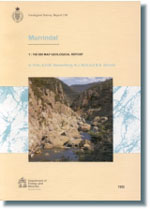GSV Report 100 - Murrindal 1:100 000 map area geological report
 |
| |||||||||||||||
Product description:Download The downloadable version of this report is supplied in PDF format (26.0MB). Abstract This report describes the geology of the area covered by the Murrindal 1:100,000 mapsheet 8523. It gives a comprehensive account of the physiography, geological history and landscape evolution, Palaeozoic and Cainozoic rock units, structural and economic geology, and a full list of references. Ordovician marine rocks are the oldest in the Murrindal 1:100,000 map area and include turbiditic sand-rich packages (Broadbent Sandstone and Pinnak Sandstone) as well as deep marine black shale-rich units of the Bendoc Group (Sunlight Creek Formation, Warbisco Shale, Akuna Mudstone) and turbidites with mafic volcanic grains in the northwestern Blueys Creek Formation. These are overlain by Early Siluriang conglomerate of the Seldom Seen Formation and quartzitic turbidites and mudstones of the Towanga Sandstone and Yalmy Group. Rifting in the Middle Silurian formed a trough which was infilled by the submarine Thorkidaan Volcanics followed by deep marine siltstone and shallow marine limestone of the Cowombat Siltstone. Also in the Middle Silurian (425-415 Ma), abundant S-type granites, and minor I-type granites in the east and south, intruded the Ordovician and Early Silurian sediments, some of which were metamorphosed to biotite schist, forming part of the more extensive Omeo Metamorphic Complex. Early Devonian rifting renewed volcanism in the area leading to the formation of the Snowy River Volcanics. Large amounts of acid, and lesser intermediate and mafic magma erupted to form lavas and pyroclastics, interbedded with lacustrine, fluvial and minor marine clastic sediments. A total of seven subgroups (Timbarra, Wombargo, White Monkey, Marroo, Berrmarr, Mount Dawson and Little River) plus some ungrouped formations, have been recognised. The end of volcanism coincided with a marine transgression, during which limestone and marlstone of the Buchan Group were deposited. Four deformations affected the palaeozoic rocks of the Murrindal 1:100,000 map area: the Early Silurian Benambran, the mid-Silurian Quidongan, the Late Silurian Bindian (= Bowning) and the Middle Devonian Tabberabberan. The Benambran only affected some of the Ordovician rocks and is better known from farther east. Most of the folding of the Ordovician and Lower Silurian rocks occurred during the Quidongan, with formation of the Yalmy Fold and Thrust Belt. The Thorkidaan Volcanics and Enano Group were tightly folded during the Bindian Deformation. The outpouring of the Snowy River Volcanics during the Early Devonian rifting was to some degree controlled by faulting, local tilting and downwarping. Many early extensional features were reactivated during the subsequent compressional Tabberabberan Deformation. The post-Palaeozoic history is one of prolonged erosion. Erosion was most severe following rejuvenation of landscape during the Cretaceous uplift. The landscape and its evolution, and the Cainozoic sedimentation and volcanism, are described in the context of this uplift. The main geophysical features of the area, and the metallic and non-metallic mineral deposits and mineral exporation history are also described. Descriptions of the petrography of the intrusive rocks and a guide for a geological excursion are given in appendices. Bibliographic reference Orth K., VandenBerg A.H.M., Nott R.J. and Simons B.A.1995. Murrindal 1: 100,000 map geological report. Geological Survey of Victoria Report 100. Related products:
| ||||||||||||||||


